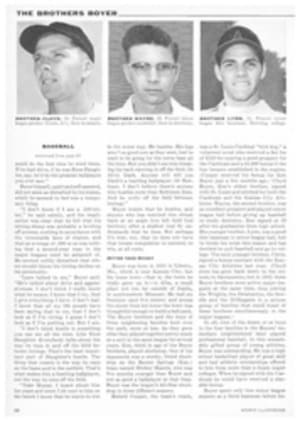
BEETLE on the BEACH
The odd butfascinating photograph on the opposite page was taken to John C. Pallister,entomologist at the American Museum of Natural History. Shapely tomatoes,roving eyes, driftwood, sand crabs, empty whisky bottles, howling infants andsurf casters are all common to beaches but this seemed to be something out ofthe ordinary, neither flotsam nor jetsam.
"That,"said Mr. Pallister, examining the picture, "is Calosoma scrutator, thegreen caterpillar hunter. It is a member of the Carabidae, the ground beetlefamily. It ranges over the entire eastern United States, although in prairiecountry it tends to be replaced by Calosoma calidum, which is black with goldenspots. Frequently it flies over water and drops in. It can stand a lot ofsubmersion.
"Thisspecimen could easily have fallen into the ocean and gotten washed ashore. Orit could have been running around on the sand hunting for food."
He raised amagnifying glass to one eye.
"It seems tohave lost one tarsus—no, there it is. But it has lost a part of one antenna.Ordinarily the green caterpillar hunter likes to climb trees for caterpillars.Inchworms are its favorite food. The grubs of this beetle live under leaves,humus and beach drift and prey on other insects.
"Do you findmany insects on beaches?" he was asked. Mr. Pallister smiledtolerantly.
"A livelyplace by day as well as by night," he said. "There is plenty going on.The casual observer wouldn't see much. They're there but you have to look forthem."
Leaning back inhis swivel chair and locking his hands behind his head, Mr. Pallister proceededto give an entomologist's version of the seashore. Sometimes it was a grimpicture featuring death struggles in the insect world. At other times it wasfilled with bug song. There was intrigue and there was beauty.
It appears thatthe beach is a place haunted by insect predators. The great, gray robber fliessit on the sand watching with bulging, expressionless eyes for something tomove. When it does, they pounce on it with the fury of a saber-toothed tiger.Robber flies often catch their prey in mid-air. They seize it with their legs,plunge their beaks into it and kill it with a potent injection. They evenoverwhelm bees, getting them from behind and knocking them out before they havea chance to strike back.
Dragonflies anddamsel flies dance in the sunlight above the beach while below them beetlescrawl. It may be Calosoma scrutator on the prowl but more likely wanderingColorado potato beetles, lady beetles or weevils. Tiger beetles, some of themgreener than emerald, are at home on the beach or near sandy areas. The larvaof the tiger beetles has a neat trick for feeding itself. It lurks in a burrowwith its head and mandibles just filling the surface opening. When someunsuspecting bug walks over it—whammo!—it snatches the victim in its jaws andretires for a subterranean meal. It also has hooks on its abdomen which lockinto the wall of the burrow.
"In case itgets hold of something a little strong, it can't be pulled out of thehole," Mr. Pallister explained.
Mr. Pallisterfinds his best bug hunting in the drift thrown up by the tide. Combing thisline of debris, he turns over driftwood and seaweed and is delighted wheninsects flee in all directions.
In fine, dry sandbeyond wave action and usually in a sheltered place next to a log he findssmall round holes shaped like inverted cones. These are the lairs ofdoodlebugs.
The doodlebug, orant lion, has a fat body and a large pair of pinchers. It travels backward.When it digs its hole it moves in a circle until it has made a depression. Thenit keeps tossing sand out of the bottom of the hole until it has formed aperfect funnel-shaped trap of loose sand. At the bottom of this pit thedoodlebug lurks completely hidden. When a scurrying ant or other heedlessinsect tumbles into the hole, it is unable to climb out again because of thebad footing on the walls of the trap. When it slides to the bottom thedoodlebug grabs with its pinchers and pulls it to oblivion beneath the sand.Mr. Pallister likes doodlebugs.
"They makenice pets," he said. "You keep them in a box of sand and provide themwith an ant occasionally."
Then he talked ofthe scarabs—the gold bug and the fig-eater—that drone over the beach at night;of the long-horned, wood-boring beetles that bumble through the darkness insearch of better wood in which to bore; of flies and fleas and molecrickets.
"The beach isa great place," Pallister said.
Then he bent overa tray of insects which he had been examining until confronted with thephotograph of Calosoma scrutator, the green caterpillar hunter.
PHOTO
JERRY COOKE

